Report on Principles of Administration: Office Management Procedures
VerifiedAdded on 2020/07/22
|16
|2909
|72
Report
AI Summary
This report delves into the principles of administration, focusing on office management and related legal requirements. It covers various aspects of facility management, including legal obligations, typical services, and the establishment of office management procedures. The report explores techniques for managing office resources, monitoring work flow, and providing support and welfare facilities for office workers. It also examines the legal obligations of employers for health and safety, individual responsibilities, and accident and emergency procedures. Furthermore, the report discusses the purpose and implications of meeting minutes, different types of minutes, and techniques for facilitating meetings. It also covers the use of targets and budgets, work allocation, quality management techniques, and event planning. The report provides insights into event characteristics, information sources, and planning processes. This report is a comprehensive guide to the principles of administration in an office setting.
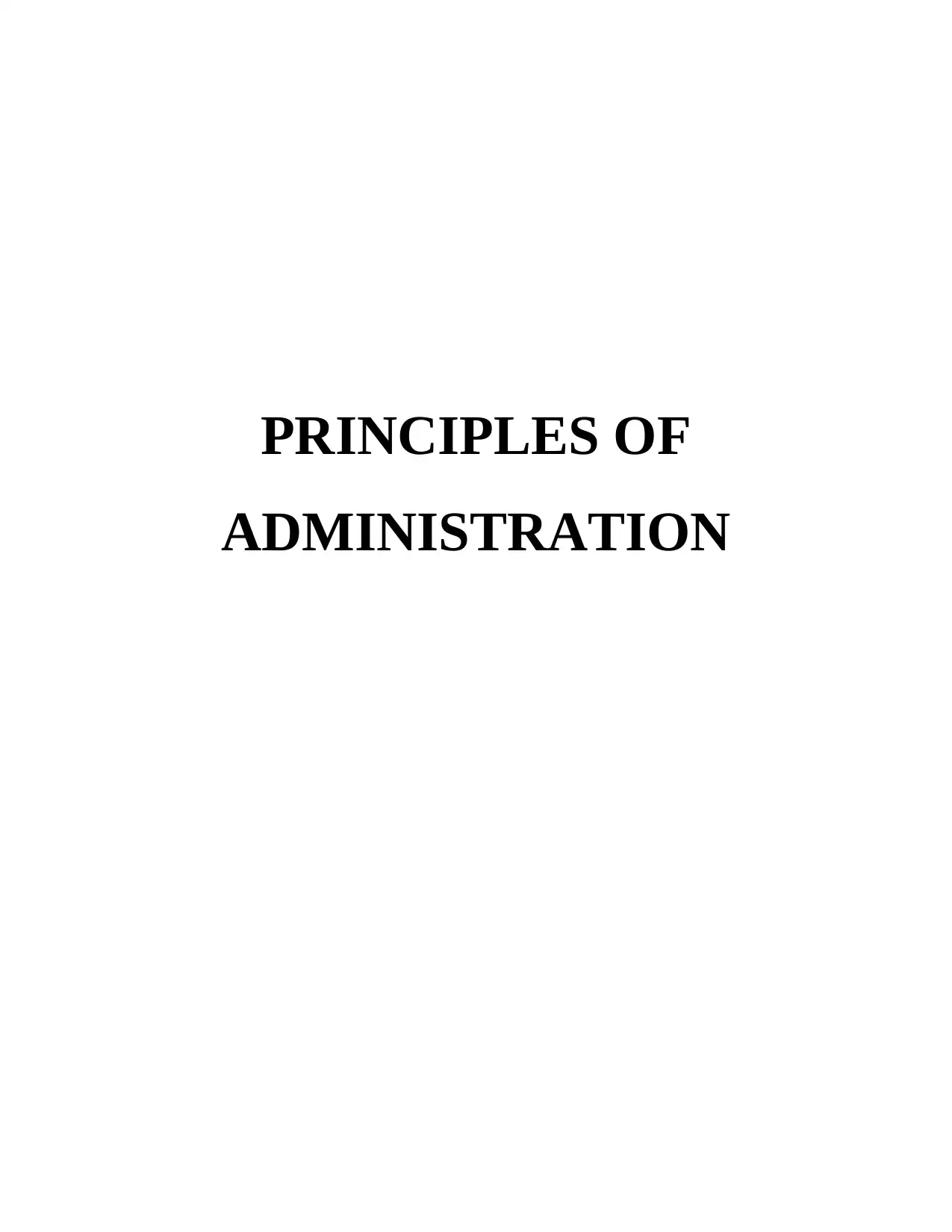
PRINCIPLES OF
ADMINISTRATION
ADMINISTRATION
Paraphrase This Document
Need a fresh take? Get an instant paraphrase of this document with our AI Paraphraser
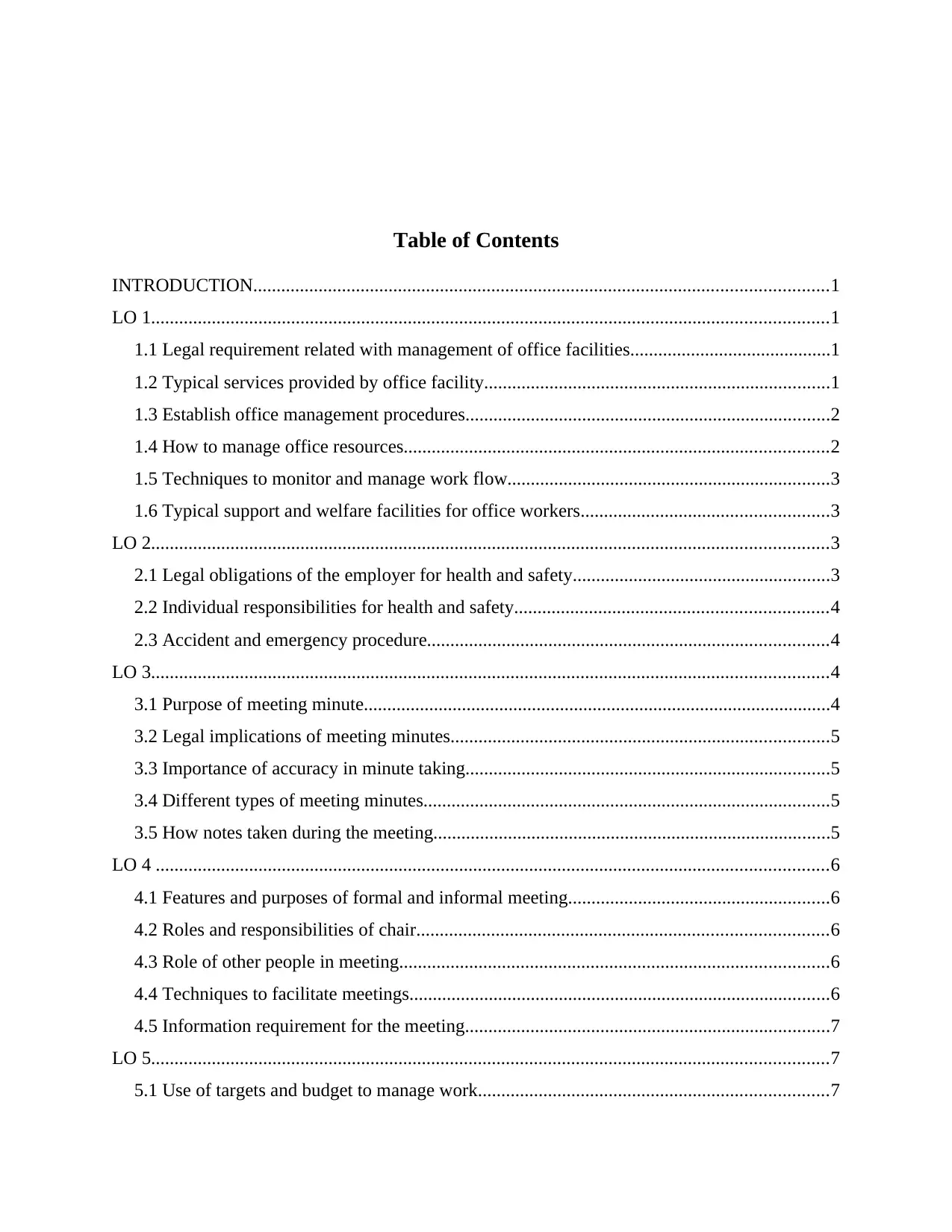
Table of Contents
INTRODUCTION...........................................................................................................................1
LO 1.................................................................................................................................................1
1.1 Legal requirement related with management of office facilities...........................................1
1.2 Typical services provided by office facility..........................................................................1
1.3 Establish office management procedures..............................................................................2
1.4 How to manage office resources...........................................................................................2
1.5 Techniques to monitor and manage work flow.....................................................................3
1.6 Typical support and welfare facilities for office workers.....................................................3
LO 2.................................................................................................................................................3
2.1 Legal obligations of the employer for health and safety.......................................................3
2.2 Individual responsibilities for health and safety...................................................................4
2.3 Accident and emergency procedure......................................................................................4
LO 3.................................................................................................................................................4
3.1 Purpose of meeting minute....................................................................................................4
3.2 Legal implications of meeting minutes.................................................................................5
3.3 Importance of accuracy in minute taking..............................................................................5
3.4 Different types of meeting minutes.......................................................................................5
3.5 How notes taken during the meeting.....................................................................................5
LO 4 ................................................................................................................................................6
4.1 Features and purposes of formal and informal meeting........................................................6
4.2 Roles and responsibilities of chair........................................................................................6
4.3 Role of other people in meeting............................................................................................6
4.4 Techniques to facilitate meetings..........................................................................................6
4.5 Information requirement for the meeting..............................................................................7
LO 5.................................................................................................................................................7
5.1 Use of targets and budget to manage work...........................................................................7
INTRODUCTION...........................................................................................................................1
LO 1.................................................................................................................................................1
1.1 Legal requirement related with management of office facilities...........................................1
1.2 Typical services provided by office facility..........................................................................1
1.3 Establish office management procedures..............................................................................2
1.4 How to manage office resources...........................................................................................2
1.5 Techniques to monitor and manage work flow.....................................................................3
1.6 Typical support and welfare facilities for office workers.....................................................3
LO 2.................................................................................................................................................3
2.1 Legal obligations of the employer for health and safety.......................................................3
2.2 Individual responsibilities for health and safety...................................................................4
2.3 Accident and emergency procedure......................................................................................4
LO 3.................................................................................................................................................4
3.1 Purpose of meeting minute....................................................................................................4
3.2 Legal implications of meeting minutes.................................................................................5
3.3 Importance of accuracy in minute taking..............................................................................5
3.4 Different types of meeting minutes.......................................................................................5
3.5 How notes taken during the meeting.....................................................................................5
LO 4 ................................................................................................................................................6
4.1 Features and purposes of formal and informal meeting........................................................6
4.2 Roles and responsibilities of chair........................................................................................6
4.3 Role of other people in meeting............................................................................................6
4.4 Techniques to facilitate meetings..........................................................................................6
4.5 Information requirement for the meeting..............................................................................7
LO 5.................................................................................................................................................7
5.1 Use of targets and budget to manage work...........................................................................7
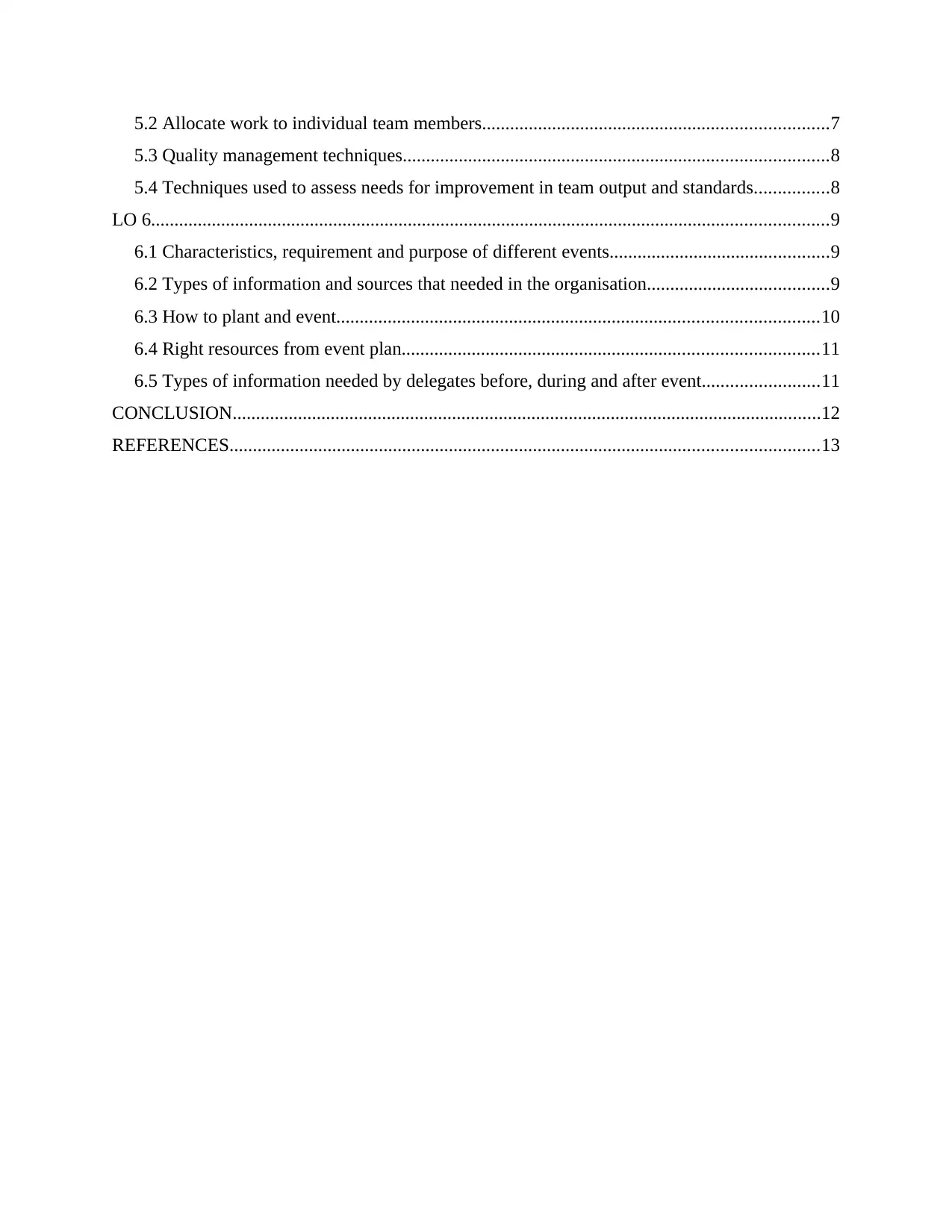
5.2 Allocate work to individual team members..........................................................................7
5.3 Quality management techniques...........................................................................................8
5.4 Techniques used to assess needs for improvement in team output and standards................8
LO 6.................................................................................................................................................9
6.1 Characteristics, requirement and purpose of different events...............................................9
6.2 Types of information and sources that needed in the organisation.......................................9
6.3 How to plant and event.......................................................................................................10
6.4 Right resources from event plan.........................................................................................11
6.5 Types of information needed by delegates before, during and after event.........................11
CONCLUSION..............................................................................................................................12
REFERENCES..............................................................................................................................13
5.3 Quality management techniques...........................................................................................8
5.4 Techniques used to assess needs for improvement in team output and standards................8
LO 6.................................................................................................................................................9
6.1 Characteristics, requirement and purpose of different events...............................................9
6.2 Types of information and sources that needed in the organisation.......................................9
6.3 How to plant and event.......................................................................................................10
6.4 Right resources from event plan.........................................................................................11
6.5 Types of information needed by delegates before, during and after event.........................11
CONCLUSION..............................................................................................................................12
REFERENCES..............................................................................................................................13
⊘ This is a preview!⊘
Do you want full access?
Subscribe today to unlock all pages.

Trusted by 1+ million students worldwide
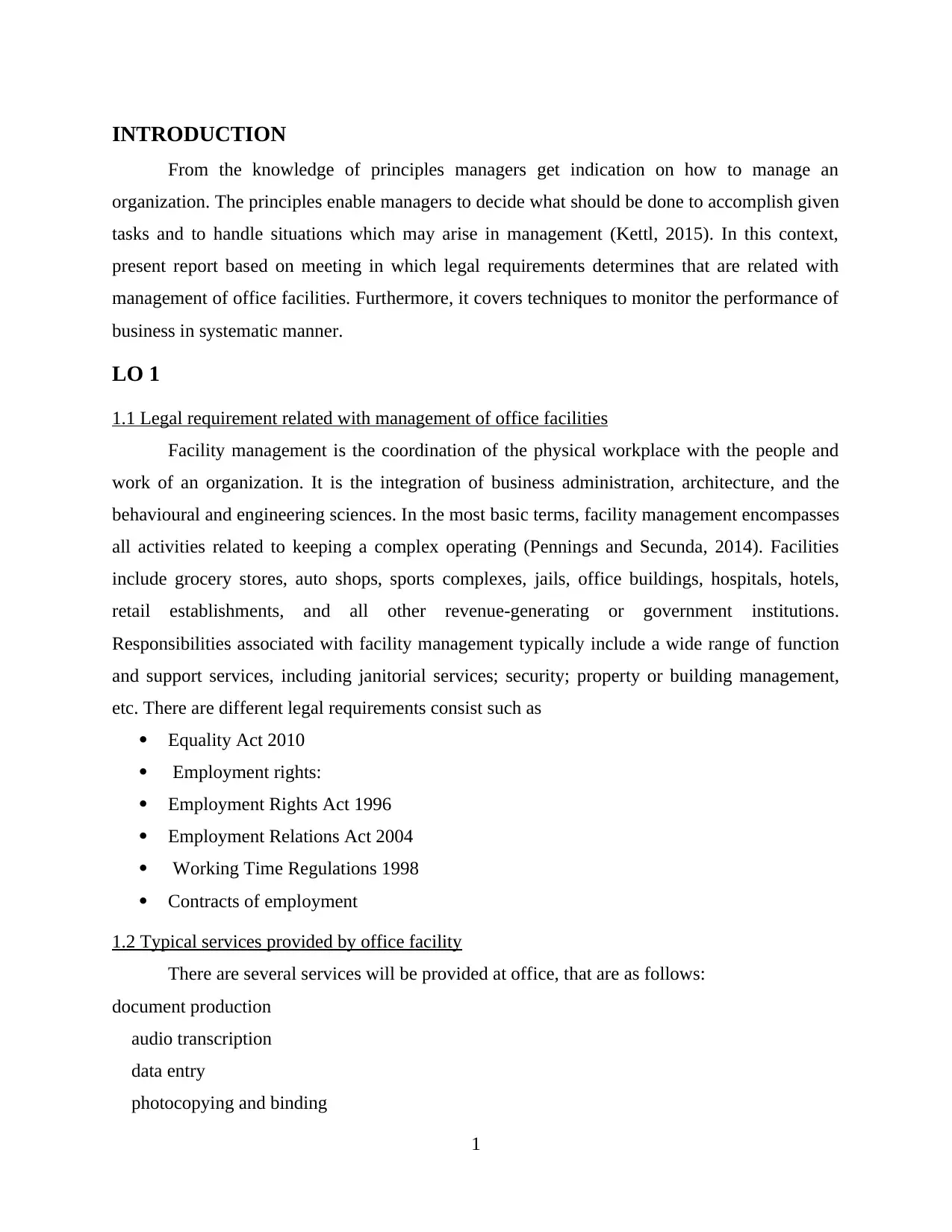
INTRODUCTION
From the knowledge of principles managers get indication on how to manage an
organization. The principles enable managers to decide what should be done to accomplish given
tasks and to handle situations which may arise in management (Kettl, 2015). In this context,
present report based on meeting in which legal requirements determines that are related with
management of office facilities. Furthermore, it covers techniques to monitor the performance of
business in systematic manner.
LO 1
1.1 Legal requirement related with management of office facilities
Facility management is the coordination of the physical workplace with the people and
work of an organization. It is the integration of business administration, architecture, and the
behavioural and engineering sciences. In the most basic terms, facility management encompasses
all activities related to keeping a complex operating (Pennings and Secunda, 2014). Facilities
include grocery stores, auto shops, sports complexes, jails, office buildings, hospitals, hotels,
retail establishments, and all other revenue-generating or government institutions.
Responsibilities associated with facility management typically include a wide range of function
and support services, including janitorial services; security; property or building management,
etc. There are different legal requirements consist such as
Equality Act 2010
Employment rights:
Employment Rights Act 1996
Employment Relations Act 2004
Working Time Regulations 1998
Contracts of employment
1.2 Typical services provided by office facility
There are several services will be provided at office, that are as follows:
document production
audio transcription
data entry
photocopying and binding
1
From the knowledge of principles managers get indication on how to manage an
organization. The principles enable managers to decide what should be done to accomplish given
tasks and to handle situations which may arise in management (Kettl, 2015). In this context,
present report based on meeting in which legal requirements determines that are related with
management of office facilities. Furthermore, it covers techniques to monitor the performance of
business in systematic manner.
LO 1
1.1 Legal requirement related with management of office facilities
Facility management is the coordination of the physical workplace with the people and
work of an organization. It is the integration of business administration, architecture, and the
behavioural and engineering sciences. In the most basic terms, facility management encompasses
all activities related to keeping a complex operating (Pennings and Secunda, 2014). Facilities
include grocery stores, auto shops, sports complexes, jails, office buildings, hospitals, hotels,
retail establishments, and all other revenue-generating or government institutions.
Responsibilities associated with facility management typically include a wide range of function
and support services, including janitorial services; security; property or building management,
etc. There are different legal requirements consist such as
Equality Act 2010
Employment rights:
Employment Rights Act 1996
Employment Relations Act 2004
Working Time Regulations 1998
Contracts of employment
1.2 Typical services provided by office facility
There are several services will be provided at office, that are as follows:
document production
audio transcription
data entry
photocopying and binding
1
Paraphrase This Document
Need a fresh take? Get an instant paraphrase of this document with our AI Paraphraser
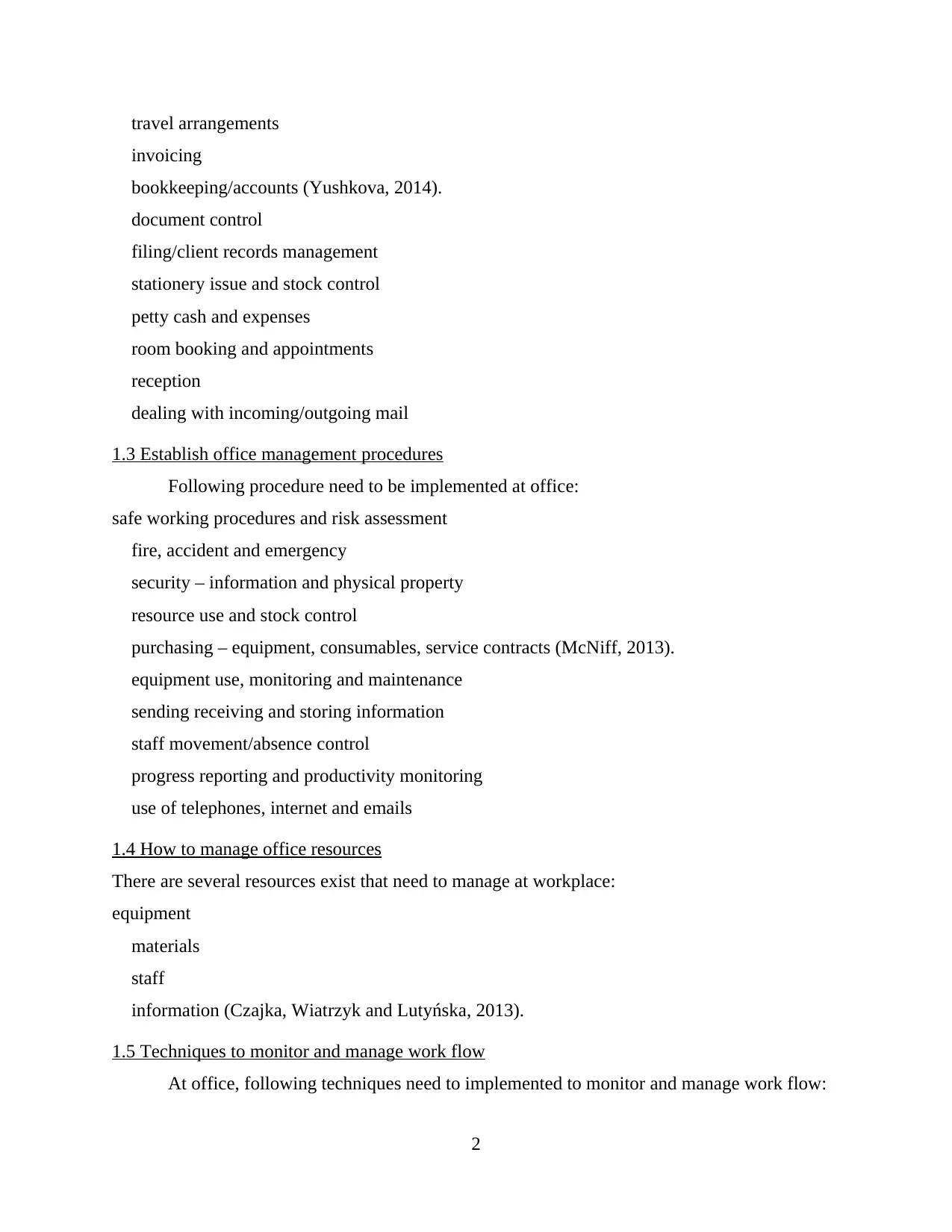
travel arrangements
invoicing
bookkeeping/accounts (Yushkova, 2014).
document control
filing/client records management
stationery issue and stock control
petty cash and expenses
room booking and appointments
reception
dealing with incoming/outgoing mail
1.3 Establish office management procedures
Following procedure need to be implemented at office:
safe working procedures and risk assessment
fire, accident and emergency
security – information and physical property
resource use and stock control
purchasing – equipment, consumables, service contracts (McNiff, 2013).
equipment use, monitoring and maintenance
sending receiving and storing information
staff movement/absence control
progress reporting and productivity monitoring
use of telephones, internet and emails
1.4 How to manage office resources
There are several resources exist that need to manage at workplace:
equipment
materials
staff
information (Czajka, Wiatrzyk and Lutyńska, 2013).
1.5 Techniques to monitor and manage work flow
At office, following techniques need to implemented to monitor and manage work flow:
2
invoicing
bookkeeping/accounts (Yushkova, 2014).
document control
filing/client records management
stationery issue and stock control
petty cash and expenses
room booking and appointments
reception
dealing with incoming/outgoing mail
1.3 Establish office management procedures
Following procedure need to be implemented at office:
safe working procedures and risk assessment
fire, accident and emergency
security – information and physical property
resource use and stock control
purchasing – equipment, consumables, service contracts (McNiff, 2013).
equipment use, monitoring and maintenance
sending receiving and storing information
staff movement/absence control
progress reporting and productivity monitoring
use of telephones, internet and emails
1.4 How to manage office resources
There are several resources exist that need to manage at workplace:
equipment
materials
staff
information (Czajka, Wiatrzyk and Lutyńska, 2013).
1.5 Techniques to monitor and manage work flow
At office, following techniques need to implemented to monitor and manage work flow:
2
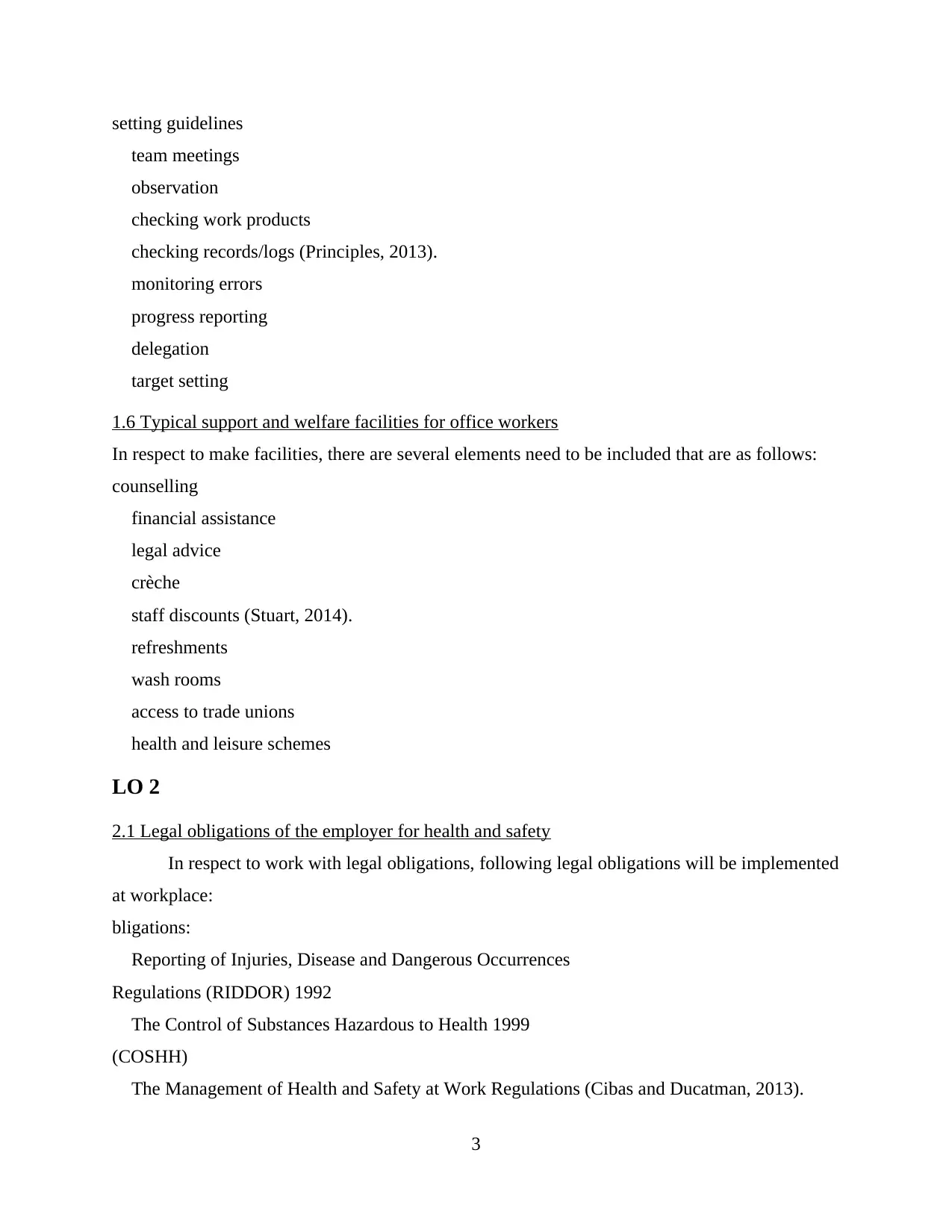
setting guidelines
team meetings
observation
checking work products
checking records/logs (Principles, 2013).
monitoring errors
progress reporting
delegation
target setting
1.6 Typical support and welfare facilities for office workers
In respect to make facilities, there are several elements need to be included that are as follows:
counselling
financial assistance
legal advice
crèche
staff discounts (Stuart, 2014).
refreshments
wash rooms
access to trade unions
health and leisure schemes
LO 2
2.1 Legal obligations of the employer for health and safety
In respect to work with legal obligations, following legal obligations will be implemented
at workplace:
bligations:
Reporting of Injuries, Disease and Dangerous Occurrences
Regulations (RIDDOR) 1992
The Control of Substances Hazardous to Health 1999
(COSHH)
The Management of Health and Safety at Work Regulations (Cibas and Ducatman, 2013).
3
team meetings
observation
checking work products
checking records/logs (Principles, 2013).
monitoring errors
progress reporting
delegation
target setting
1.6 Typical support and welfare facilities for office workers
In respect to make facilities, there are several elements need to be included that are as follows:
counselling
financial assistance
legal advice
crèche
staff discounts (Stuart, 2014).
refreshments
wash rooms
access to trade unions
health and leisure schemes
LO 2
2.1 Legal obligations of the employer for health and safety
In respect to work with legal obligations, following legal obligations will be implemented
at workplace:
bligations:
Reporting of Injuries, Disease and Dangerous Occurrences
Regulations (RIDDOR) 1992
The Control of Substances Hazardous to Health 1999
(COSHH)
The Management of Health and Safety at Work Regulations (Cibas and Ducatman, 2013).
3
⊘ This is a preview!⊘
Do you want full access?
Subscribe today to unlock all pages.

Trusted by 1+ million students worldwide
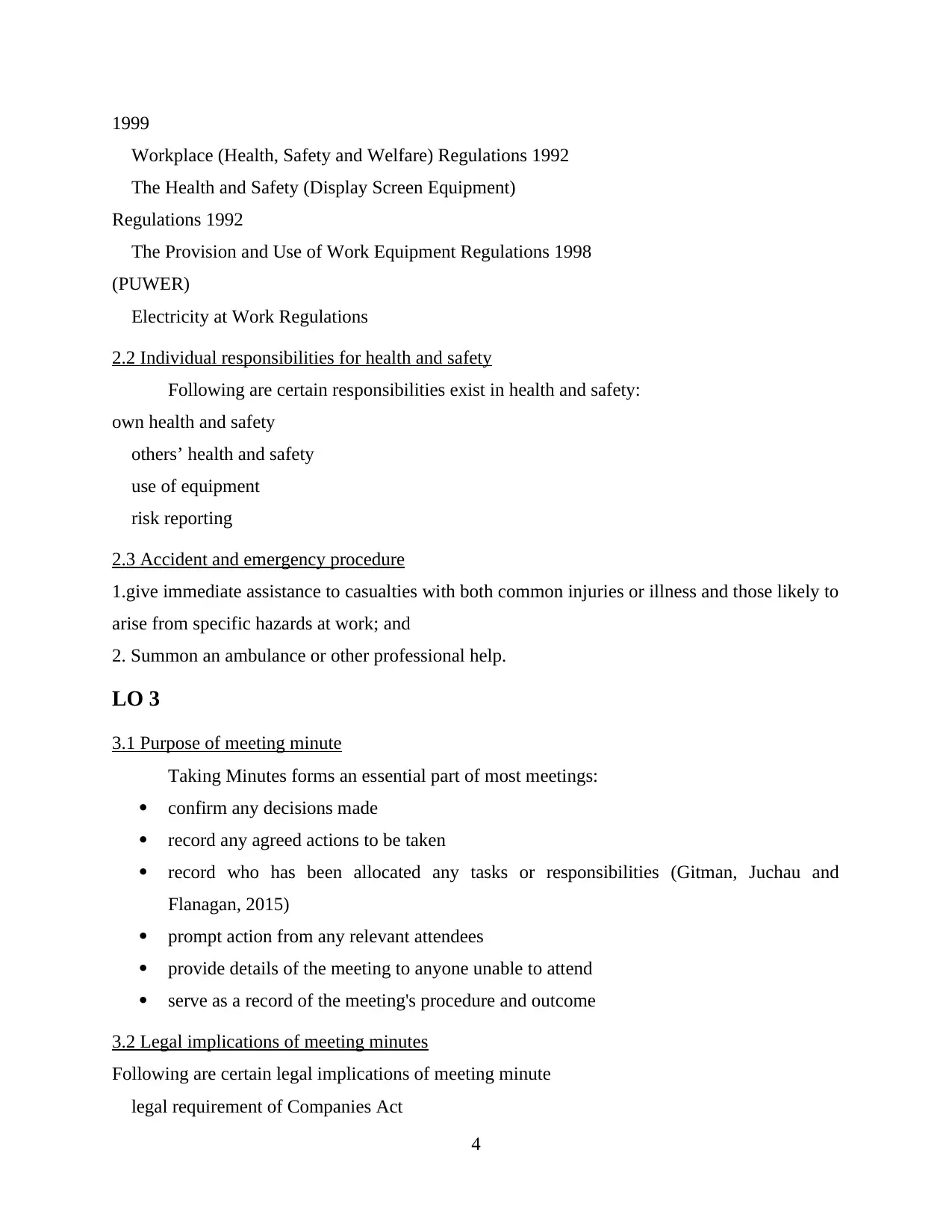
1999
Workplace (Health, Safety and Welfare) Regulations 1992
The Health and Safety (Display Screen Equipment)
Regulations 1992
The Provision and Use of Work Equipment Regulations 1998
(PUWER)
Electricity at Work Regulations
2.2 Individual responsibilities for health and safety
Following are certain responsibilities exist in health and safety:
own health and safety
others’ health and safety
use of equipment
risk reporting
2.3 Accident and emergency procedure
1.give immediate assistance to casualties with both common injuries or illness and those likely to
arise from specific hazards at work; and
2. Summon an ambulance or other professional help.
LO 3
3.1 Purpose of meeting minute
Taking Minutes forms an essential part of most meetings:
confirm any decisions made
record any agreed actions to be taken
record who has been allocated any tasks or responsibilities (Gitman, Juchau and
Flanagan, 2015)
prompt action from any relevant attendees
provide details of the meeting to anyone unable to attend
serve as a record of the meeting's procedure and outcome
3.2 Legal implications of meeting minutes
Following are certain legal implications of meeting minute
legal requirement of Companies Act
4
Workplace (Health, Safety and Welfare) Regulations 1992
The Health and Safety (Display Screen Equipment)
Regulations 1992
The Provision and Use of Work Equipment Regulations 1998
(PUWER)
Electricity at Work Regulations
2.2 Individual responsibilities for health and safety
Following are certain responsibilities exist in health and safety:
own health and safety
others’ health and safety
use of equipment
risk reporting
2.3 Accident and emergency procedure
1.give immediate assistance to casualties with both common injuries or illness and those likely to
arise from specific hazards at work; and
2. Summon an ambulance or other professional help.
LO 3
3.1 Purpose of meeting minute
Taking Minutes forms an essential part of most meetings:
confirm any decisions made
record any agreed actions to be taken
record who has been allocated any tasks or responsibilities (Gitman, Juchau and
Flanagan, 2015)
prompt action from any relevant attendees
provide details of the meeting to anyone unable to attend
serve as a record of the meeting's procedure and outcome
3.2 Legal implications of meeting minutes
Following are certain legal implications of meeting minute
legal requirement of Companies Act
4
Paraphrase This Document
Need a fresh take? Get an instant paraphrase of this document with our AI Paraphraser
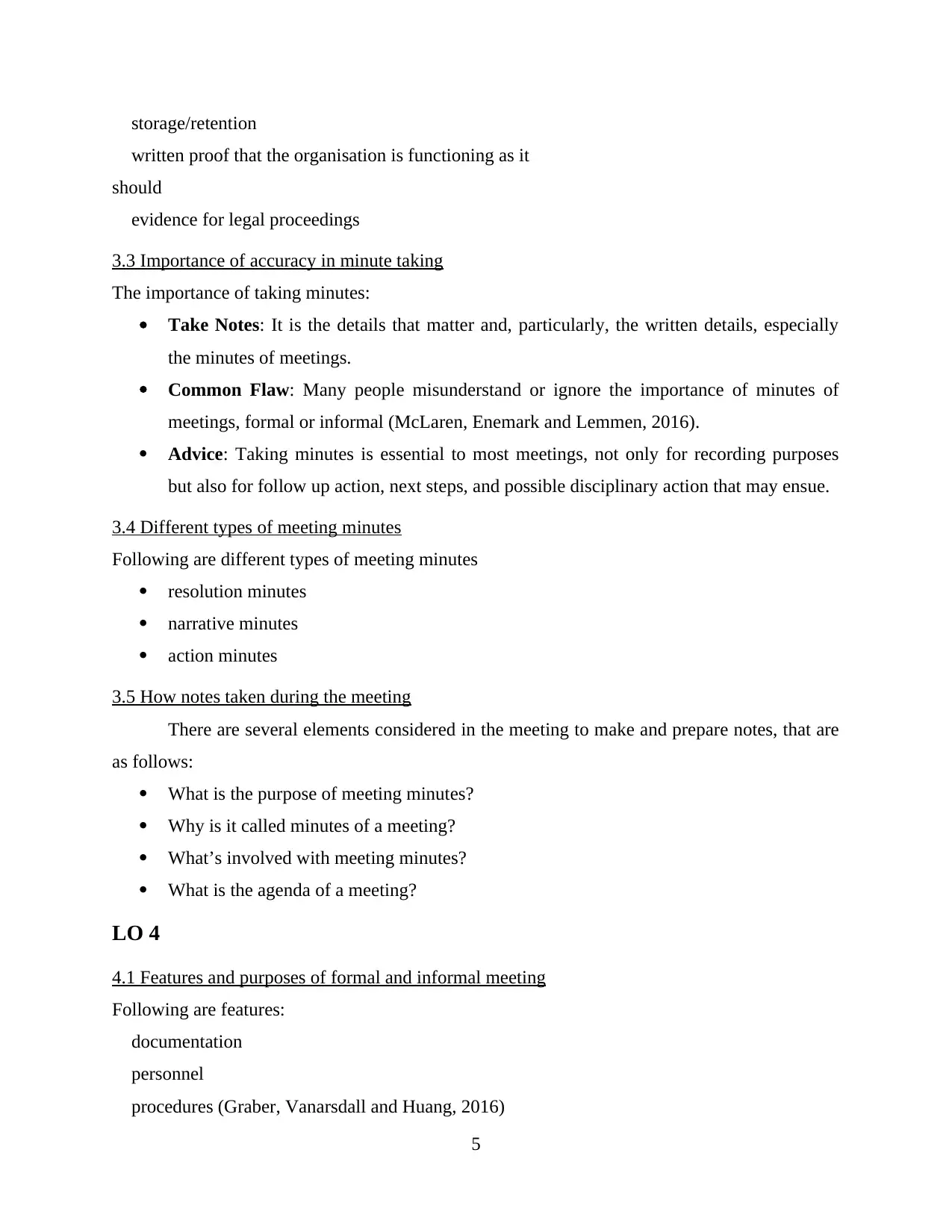
storage/retention
written proof that the organisation is functioning as it
should
evidence for legal proceedings
3.3 Importance of accuracy in minute taking
The importance of taking minutes:
Take Notes: It is the details that matter and, particularly, the written details, especially
the minutes of meetings.
Common Flaw: Many people misunderstand or ignore the importance of minutes of
meetings, formal or informal (McLaren, Enemark and Lemmen, 2016).
Advice: Taking minutes is essential to most meetings, not only for recording purposes
but also for follow up action, next steps, and possible disciplinary action that may ensue.
3.4 Different types of meeting minutes
Following are different types of meeting minutes
resolution minutes
narrative minutes
action minutes
3.5 How notes taken during the meeting
There are several elements considered in the meeting to make and prepare notes, that are
as follows:
What is the purpose of meeting minutes?
Why is it called minutes of a meeting?
What’s involved with meeting minutes?
What is the agenda of a meeting?
LO 4
4.1 Features and purposes of formal and informal meeting
Following are features:
documentation
personnel
procedures (Graber, Vanarsdall and Huang, 2016)
5
written proof that the organisation is functioning as it
should
evidence for legal proceedings
3.3 Importance of accuracy in minute taking
The importance of taking minutes:
Take Notes: It is the details that matter and, particularly, the written details, especially
the minutes of meetings.
Common Flaw: Many people misunderstand or ignore the importance of minutes of
meetings, formal or informal (McLaren, Enemark and Lemmen, 2016).
Advice: Taking minutes is essential to most meetings, not only for recording purposes
but also for follow up action, next steps, and possible disciplinary action that may ensue.
3.4 Different types of meeting minutes
Following are different types of meeting minutes
resolution minutes
narrative minutes
action minutes
3.5 How notes taken during the meeting
There are several elements considered in the meeting to make and prepare notes, that are
as follows:
What is the purpose of meeting minutes?
Why is it called minutes of a meeting?
What’s involved with meeting minutes?
What is the agenda of a meeting?
LO 4
4.1 Features and purposes of formal and informal meeting
Following are features:
documentation
personnel
procedures (Graber, Vanarsdall and Huang, 2016)
5
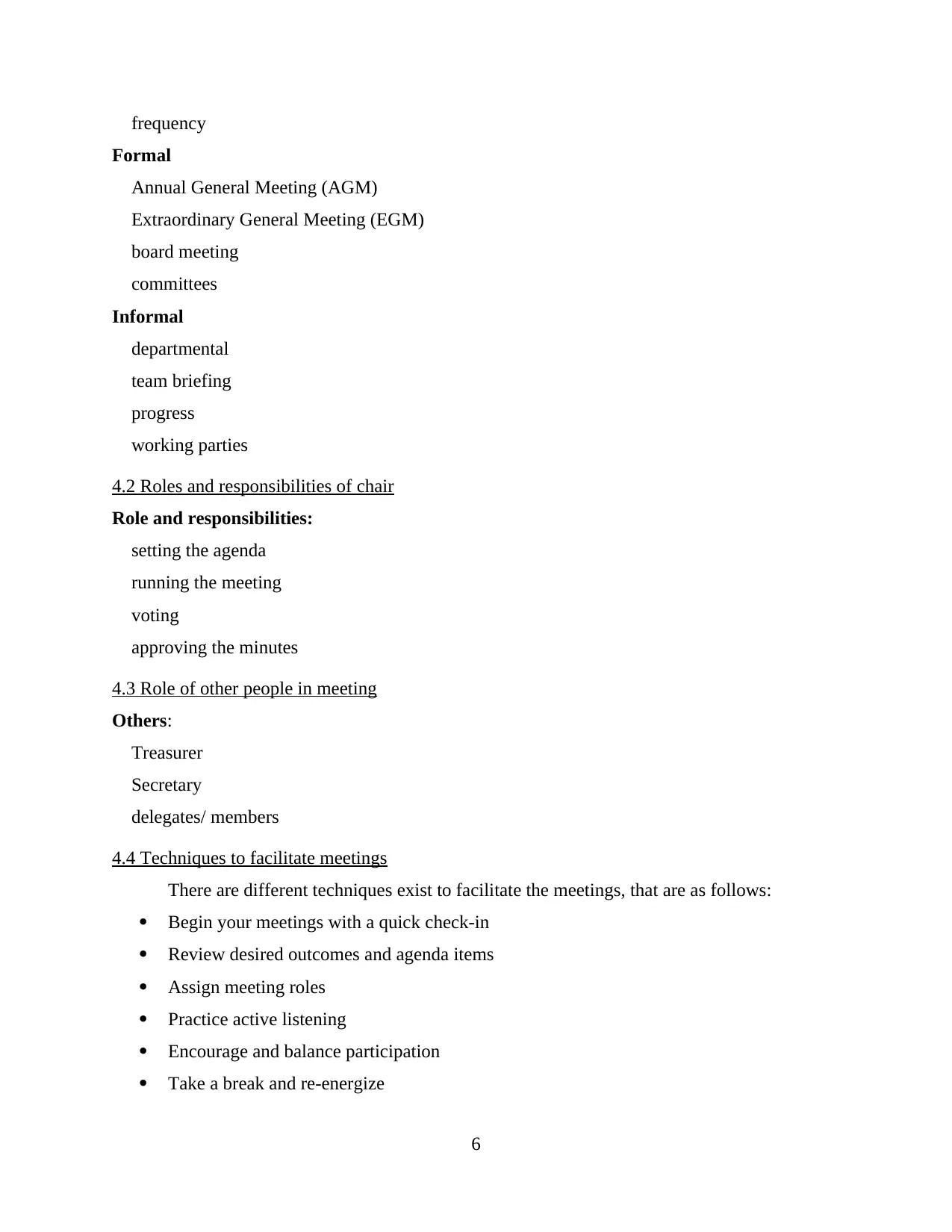
frequency
Formal
Annual General Meeting (AGM)
Extraordinary General Meeting (EGM)
board meeting
committees
Informal
departmental
team briefing
progress
working parties
4.2 Roles and responsibilities of chair
Role and responsibilities:
setting the agenda
running the meeting
voting
approving the minutes
4.3 Role of other people in meeting
Others:
Treasurer
Secretary
delegates/ members
4.4 Techniques to facilitate meetings
There are different techniques exist to facilitate the meetings, that are as follows:
Begin your meetings with a quick check-in
Review desired outcomes and agenda items
Assign meeting roles
Practice active listening
Encourage and balance participation
Take a break and re-energize
6
Formal
Annual General Meeting (AGM)
Extraordinary General Meeting (EGM)
board meeting
committees
Informal
departmental
team briefing
progress
working parties
4.2 Roles and responsibilities of chair
Role and responsibilities:
setting the agenda
running the meeting
voting
approving the minutes
4.3 Role of other people in meeting
Others:
Treasurer
Secretary
delegates/ members
4.4 Techniques to facilitate meetings
There are different techniques exist to facilitate the meetings, that are as follows:
Begin your meetings with a quick check-in
Review desired outcomes and agenda items
Assign meeting roles
Practice active listening
Encourage and balance participation
Take a break and re-energize
6
⊘ This is a preview!⊘
Do you want full access?
Subscribe today to unlock all pages.

Trusted by 1+ million students worldwide
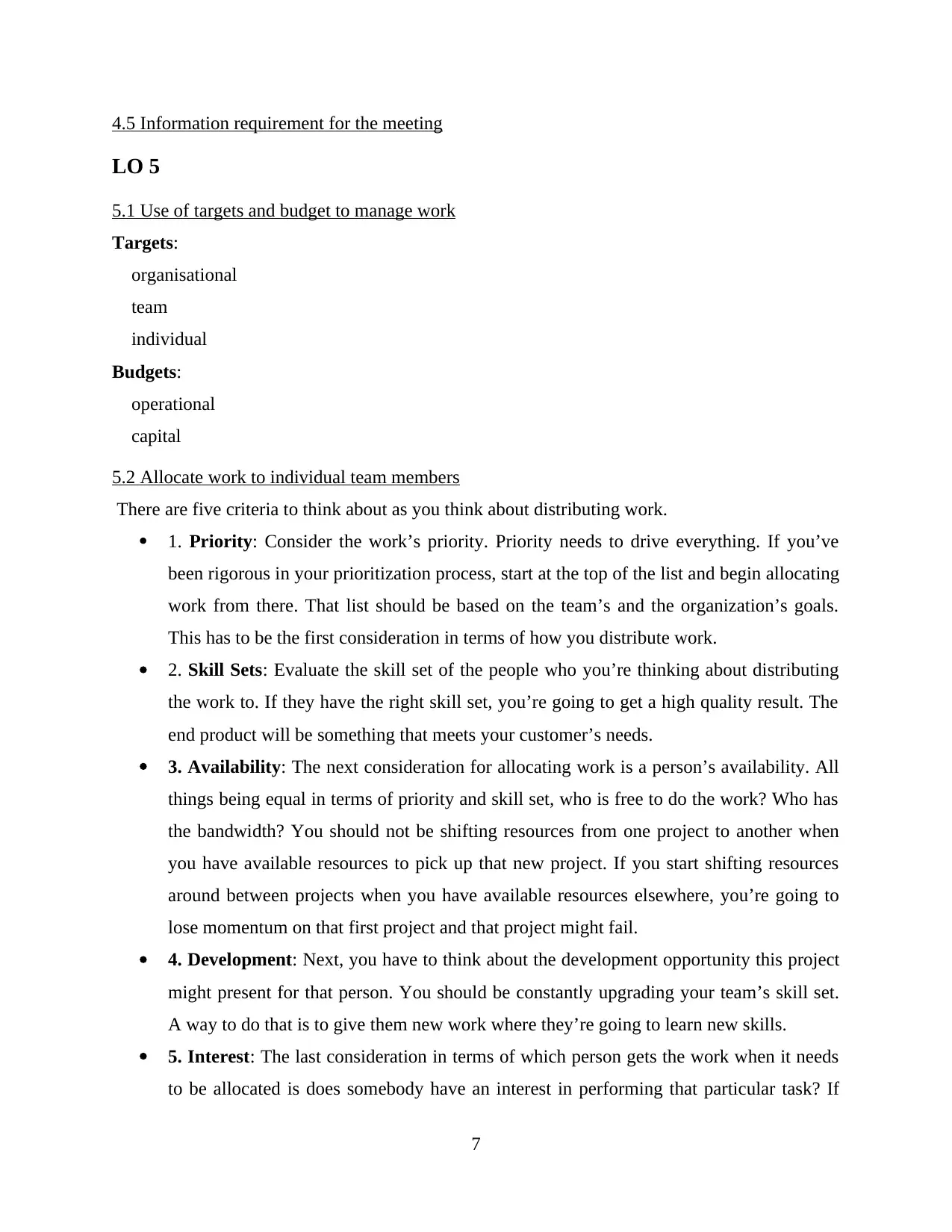
4.5 Information requirement for the meeting
LO 5
5.1 Use of targets and budget to manage work
Targets:
organisational
team
individual
Budgets:
operational
capital
5.2 Allocate work to individual team members
There are five criteria to think about as you think about distributing work.
1. Priority: Consider the work’s priority. Priority needs to drive everything. If you’ve
been rigorous in your prioritization process, start at the top of the list and begin allocating
work from there. That list should be based on the team’s and the organization’s goals.
This has to be the first consideration in terms of how you distribute work.
2. Skill Sets: Evaluate the skill set of the people who you’re thinking about distributing
the work to. If they have the right skill set, you’re going to get a high quality result. The
end product will be something that meets your customer’s needs.
3. Availability: The next consideration for allocating work is a person’s availability. All
things being equal in terms of priority and skill set, who is free to do the work? Who has
the bandwidth? You should not be shifting resources from one project to another when
you have available resources to pick up that new project. If you start shifting resources
around between projects when you have available resources elsewhere, you’re going to
lose momentum on that first project and that project might fail.
4. Development: Next, you have to think about the development opportunity this project
might present for that person. You should be constantly upgrading your team’s skill set.
A way to do that is to give them new work where they’re going to learn new skills.
5. Interest: The last consideration in terms of which person gets the work when it needs
to be allocated is does somebody have an interest in performing that particular task? If
7
LO 5
5.1 Use of targets and budget to manage work
Targets:
organisational
team
individual
Budgets:
operational
capital
5.2 Allocate work to individual team members
There are five criteria to think about as you think about distributing work.
1. Priority: Consider the work’s priority. Priority needs to drive everything. If you’ve
been rigorous in your prioritization process, start at the top of the list and begin allocating
work from there. That list should be based on the team’s and the organization’s goals.
This has to be the first consideration in terms of how you distribute work.
2. Skill Sets: Evaluate the skill set of the people who you’re thinking about distributing
the work to. If they have the right skill set, you’re going to get a high quality result. The
end product will be something that meets your customer’s needs.
3. Availability: The next consideration for allocating work is a person’s availability. All
things being equal in terms of priority and skill set, who is free to do the work? Who has
the bandwidth? You should not be shifting resources from one project to another when
you have available resources to pick up that new project. If you start shifting resources
around between projects when you have available resources elsewhere, you’re going to
lose momentum on that first project and that project might fail.
4. Development: Next, you have to think about the development opportunity this project
might present for that person. You should be constantly upgrading your team’s skill set.
A way to do that is to give them new work where they’re going to learn new skills.
5. Interest: The last consideration in terms of which person gets the work when it needs
to be allocated is does somebody have an interest in performing that particular task? If
7
Paraphrase This Document
Need a fresh take? Get an instant paraphrase of this document with our AI Paraphraser
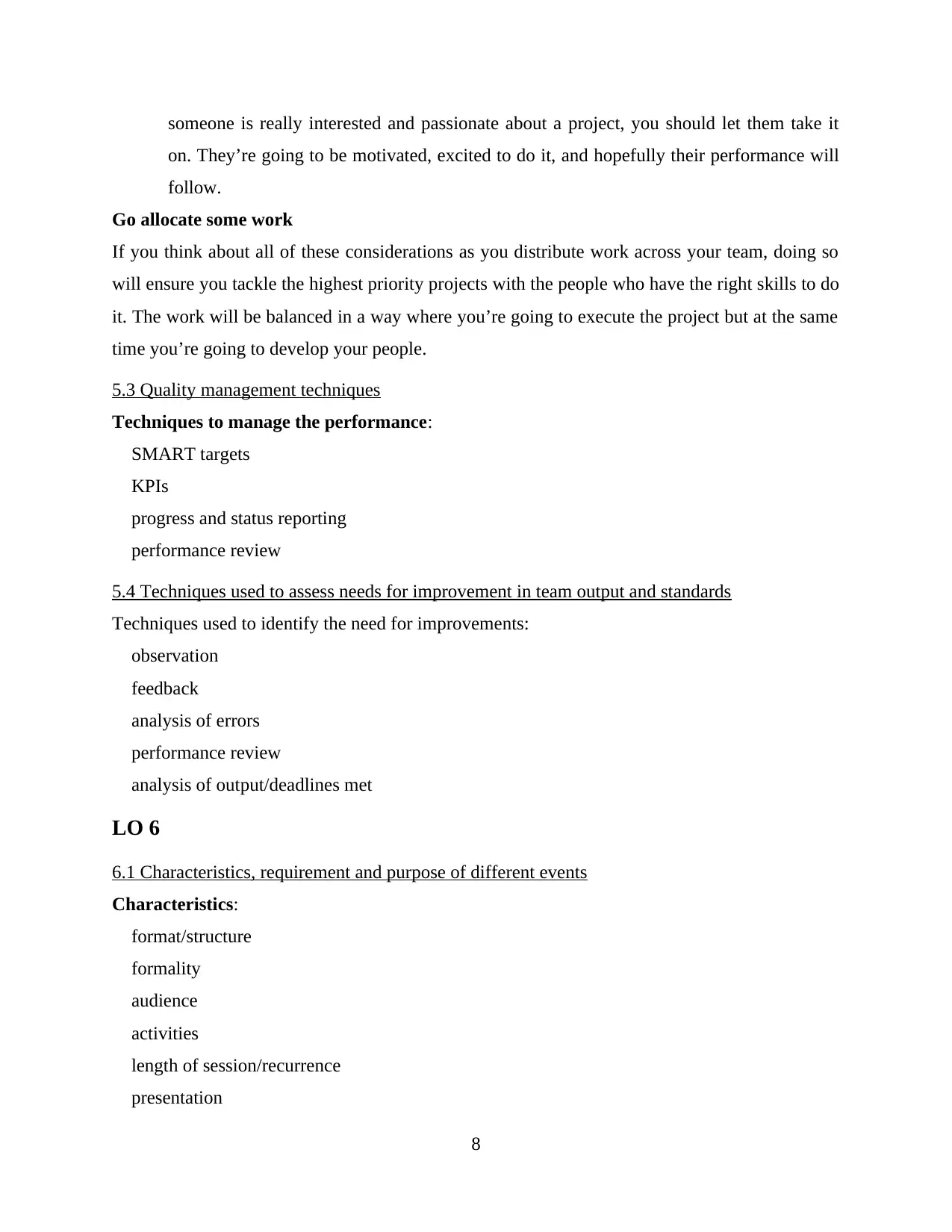
someone is really interested and passionate about a project, you should let them take it
on. They’re going to be motivated, excited to do it, and hopefully their performance will
follow.
Go allocate some work
If you think about all of these considerations as you distribute work across your team, doing so
will ensure you tackle the highest priority projects with the people who have the right skills to do
it. The work will be balanced in a way where you’re going to execute the project but at the same
time you’re going to develop your people.
5.3 Quality management techniques
Techniques to manage the performance:
SMART targets
KPIs
progress and status reporting
performance review
5.4 Techniques used to assess needs for improvement in team output and standards
Techniques used to identify the need for improvements:
observation
feedback
analysis of errors
performance review
analysis of output/deadlines met
LO 6
6.1 Characteristics, requirement and purpose of different events
Characteristics:
format/structure
formality
audience
activities
length of session/recurrence
presentation
8
on. They’re going to be motivated, excited to do it, and hopefully their performance will
follow.
Go allocate some work
If you think about all of these considerations as you distribute work across your team, doing so
will ensure you tackle the highest priority projects with the people who have the right skills to do
it. The work will be balanced in a way where you’re going to execute the project but at the same
time you’re going to develop your people.
5.3 Quality management techniques
Techniques to manage the performance:
SMART targets
KPIs
progress and status reporting
performance review
5.4 Techniques used to assess needs for improvement in team output and standards
Techniques used to identify the need for improvements:
observation
feedback
analysis of errors
performance review
analysis of output/deadlines met
LO 6
6.1 Characteristics, requirement and purpose of different events
Characteristics:
format/structure
formality
audience
activities
length of session/recurrence
presentation
8
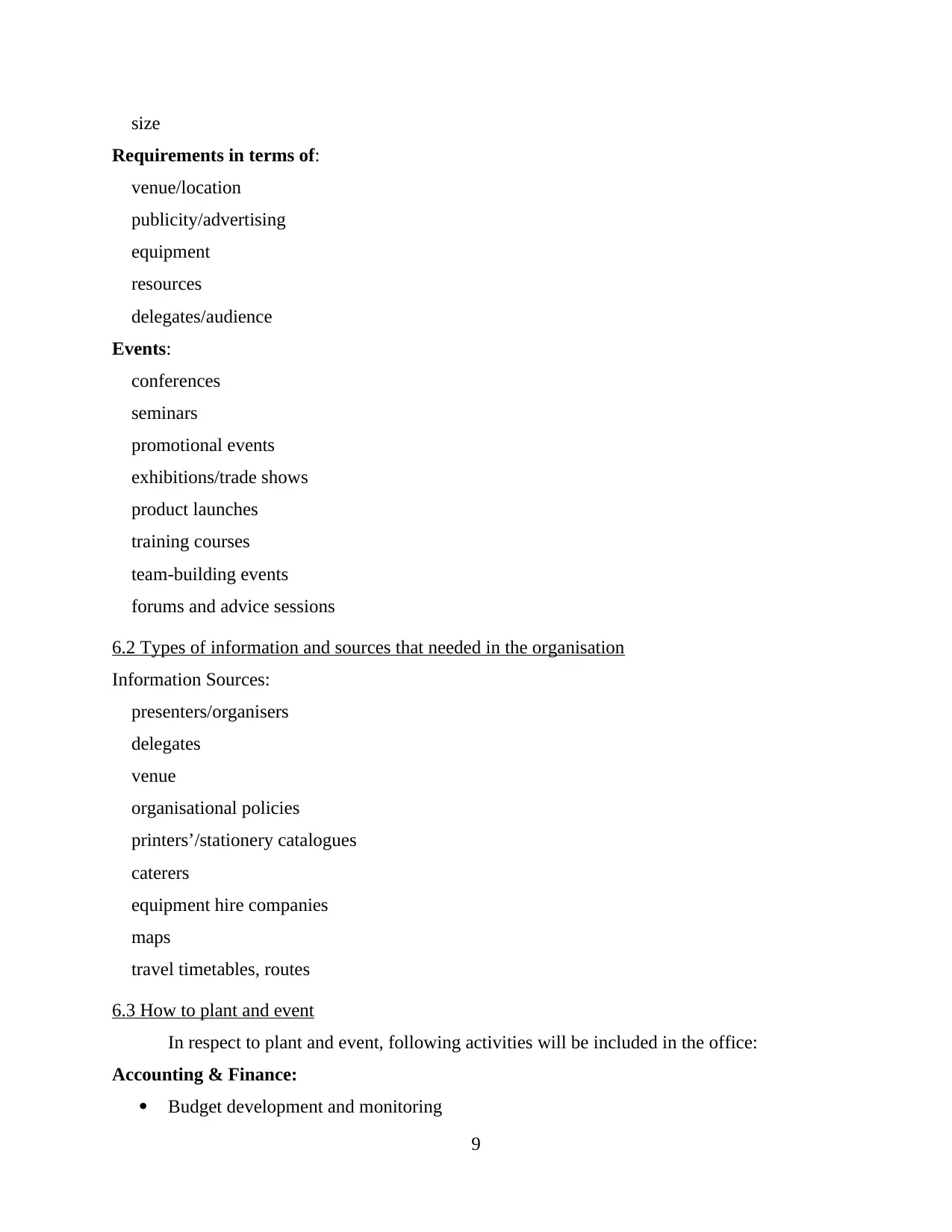
size
Requirements in terms of:
venue/location
publicity/advertising
equipment
resources
delegates/audience
Events:
conferences
seminars
promotional events
exhibitions/trade shows
product launches
training courses
team-building events
forums and advice sessions
6.2 Types of information and sources that needed in the organisation
Information Sources:
presenters/organisers
delegates
venue
organisational policies
printers’/stationery catalogues
caterers
equipment hire companies
maps
travel timetables, routes
6.3 How to plant and event
In respect to plant and event, following activities will be included in the office:
Accounting & Finance:
Budget development and monitoring
9
Requirements in terms of:
venue/location
publicity/advertising
equipment
resources
delegates/audience
Events:
conferences
seminars
promotional events
exhibitions/trade shows
product launches
training courses
team-building events
forums and advice sessions
6.2 Types of information and sources that needed in the organisation
Information Sources:
presenters/organisers
delegates
venue
organisational policies
printers’/stationery catalogues
caterers
equipment hire companies
maps
travel timetables, routes
6.3 How to plant and event
In respect to plant and event, following activities will be included in the office:
Accounting & Finance:
Budget development and monitoring
9
⊘ This is a preview!⊘
Do you want full access?
Subscribe today to unlock all pages.

Trusted by 1+ million students worldwide
1 out of 16
Related Documents
Your All-in-One AI-Powered Toolkit for Academic Success.
+13062052269
info@desklib.com
Available 24*7 on WhatsApp / Email
![[object Object]](/_next/static/media/star-bottom.7253800d.svg)
Unlock your academic potential
Copyright © 2020–2025 A2Z Services. All Rights Reserved. Developed and managed by ZUCOL.





